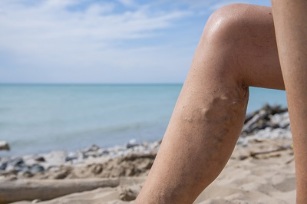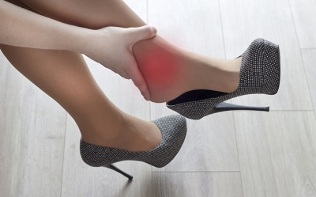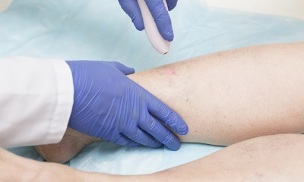
One of the problems of many women and approximately 15% of men is varicose veins in the legs. In this disease, the vessels of the legs (veins), which return blood rich in carbon dioxide and waste products of metabolism, become deformed, dilated, lose their tone and appear under the skin.
In addition to cosmetic defects, changes in the structure of the veins and impaired blood circulation cause discomfort in the legs and even pain, edema and a feeling of heaviness. Although there are several tools and medical procedures that help in the treatment, it is important from the beginning, as soon as the first signs of varicose veins appear, to participate in the prevention; This will help prevent pain, swelling, tired legs, and external cosmetic defects.
What's the matter?
Varicose veins, commonly called varicose veins, are severe changes in the vein wall, its weakness, excessive stretching, due to which dark blue or purple twisted swollen veins appear under the skin. In the initial stage, small "stars" of dilated capillaries may appear, small crowns and later larger ones.
Veins have a special structure: in addition to the elastic wall, they also have small valves (pockets) that prevent blood from flowing in the opposite direction. Varicose veins form when the valves in the vein walls weaken, stretch, deform, and do not close completely. Excessive stretching of the walls and valve defects ultimately lead to the fact that blood flows worse through the vessels, its movement slows down and even stops. First, small "star" or spider leg veins appear, then thicker twisted veins appear.
Other symptoms of varicose veins can manifest as:
- burning in calf, palpitation sensation;
- discomfort in the legs, feeling of heaviness or pain;
- muscle spasms, cramps, most noticeable at night;
- swelling of feet and ankles;
- pale, dry, or itchy skin that appears thinner than healthy skin
If there is a tendency to varicose veins or the first symptoms appear, there are a series of procedures that eliminate discomfort and pain in the legs, help improve blood circulation and tone the veins.
Exercise and physical activity

Regular exercise improves blood circulation in the legs. Muscle contraction helps push the blood that has collected in the veins. Exercise also helps lower blood pressure, which is another negative factor that contributes to varicose veins.
Low intensity exercise helps to contract the calf muscles. They work without undue stress.
Effective low-impact exercises include:
- swimming;
- walking;
- cycling;
- yoga.
Compression stockings and pantyhose
Compression stockings are available in most pharmacies and orthopedic stores. They distribute the pressure to the legs, squeezing the walls of the veins from the outside. Helps move blood to the heart and relieve blood congestion in the lower extremities. The study found that people who wore knee-high compression stockings maintained pressure between 18 and 21 mmHg. Within a week, he noticed a reduction in pain and discomfort associated with varicose veins. It is important to choose stockings and tights with a doctor or hairdresser so as not to be confused with the degree of compression.
Plant extracts
Studies have shown that horse chestnut extract can help relieve leg pain, heaviness, and itchy skin in people with chronic venous insufficiency (a leading cause of varicose veins).
A review study reported that sea pine extract and butcher's broom extract can reduce swelling or edema of the legs, which is often associated with varicose veins.
Plant extracts and essential oils should be diluted before applying to the skin or used in an aromatherapy diffuser.
Diet changes

Salty or sodium-rich foods contribute to swelling, including in the feet and ankles, so cutting down on salty foods can minimize water retention. Foods rich in potassium like almonds and pistachios help in the prevention and treatment of varicose veins by reducing water retention in the body. This group includes:
- almonds and pistachios;
- lentils and white beans;
- potato;
- leafy vegetables;
- some types of fish, such as salmon and tuna.
Fiber foods help maintain bowel function and prevent constipation. This can be important, as stress can damage the valves or cause blood to become blocked in the veins. High fiber foods include:
- nuts, seeds and legumes;
- oats, wheat and linseed;
- whole grains.
Overweight people are more likely to suffer from varicose veins, so losing extra pounds can reduce pressure on the veins, reduce swelling and discomfort.
Flavonoids in food
Adding foods that contain flavonoids to the diet also helps reduce the risk of varicose veins. Flavonoids, being biologically active substances, improve blood circulation, maintain uniform blood flow and reduce the likelihood of accumulation of blood in the veins. They also help lower the blood pressure in the arteries and relax the blood vessels, reducing stress on the veins and reducing the risk of varicose veins.
Foods that contain flavonoids include:
- vegetables: green onions, bell peppers, spinach and broccoli;
- citrus and grapes, cherries, apples and blueberries;
- cocoa;
- garlic.
Herbal remedies
Some herbal preparations help to tone the veins and reduce their deformation. Taking grape seed extract is believed to reduce leg swelling and other symptoms of chronic venous insufficiency, although there is currently little evidence of its effectiveness. If you are taking blood thinning medications, you should avoid taking grape seed extract as a dietary supplement as it can interact with the medication and increase the risk of bleeding.
Choosing the right clothes

Wearing tight, tight, synthetic clothing can restrict blood flow in your legs. Wearing loose-fitting, breathable clothing that does not restrict blood supply to the lower body improves blood flow through the veins and reduces valve deformation.
It is also prohibited to wear tight and tight shoes. Shoes with narrow toes put pressure on blood vessels and cause pain. It is recommended to choose shoes with orthopedic insoles.
Wearing shoes with low heels or with a comfortable and stable sole instead of high heels can also help relieve pain from varicose veins in the legs.
I need to lift my legs more often
Periodically raising the legs upward, ideally at the same height as the heart, or more, helps improve circulation. This reduces pressure on the veins in the legs, and gravity helps blood flow back to the heart smoothly. You should try to lift your legs if you intend to sit for long periods of time, such as when working or resting.
Massage
Lightly massaging your feet, legs, and thighs can keep the blood in your veins. You can use mild or moisturizing massage oils for optimal results. However, it is extremely important to avoid pressure directly on the veins, as this can damage the fragile tissue. No less useful massage with jets of water in the shower, including a contrast one.
Constant motion
Avoid sitting for long periods. If you have to sit at work for a long time, you have to make an effort to get up and move, or at least change positions frequently so that the blood flows completely through the veins from the legs.
Avoid sitting cross-legged, as this can further restrict blood flow to the legs and feet and aggravate circulatory problems.
Treatment procedures for varicose veins

If preventive measures at home have not improved the condition of your veins, severe discomfort, pain and swelling occur, medical treatment is necessary to eliminate varicose veins.
The doctor may prescribe the following:
- Endothermic ablation.This is a procedure in which heat is applied to seal the affected veins;
- Ambulatory phlebectomyThe doctor pierces the skin and removes the varicose veins through small incisions. The procedure is performed under local anesthesia, practically no scars remain;
- Sclerotherapy.This procedure uses a special foam to close damaged veins. Blood will flow through the bypass vein system;
- Ligation and removal.In this procedure, varicose veins are surgically removed;
- Laser operations.Intense bursts of light are directed at the vein, causing it to vanish;
- Endoscopic Surgery.During this operation, a small video camera is inserted into the leg to help the surgeon better see what is happening in the veins. The veins are removed through several small incisions.
Future predictions
Varicose veins cause discomfort and cosmetic defects. Varicose veins can be prevented at home, and diet and lifestyle changes can reduce unpleasant symptoms. But as the disease progresses, you should seek medical help to remove visible defects and heal the veins themselves.






































